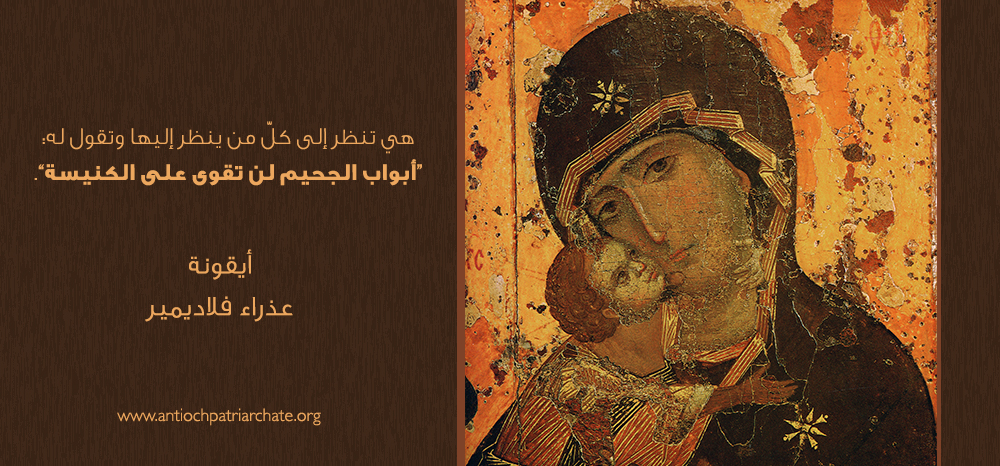
Page under translation
Page under translation
The Vladimir Icon of the Virgin Mary
- Introduction:
The icon of the Vladimir Virgin (Vladimirskaya in Russian) is one of the most venerated icons in the Orthodox Church, especially in the Russian Church. It has witnessed big events in the history of Russia.
This icon is full with spiritual and theological meanings in addition to its historical importance.
- Description:
The icon is 104 cm long x 69 cm large.
It is a combination of two prototypes of icons of the Mother of God.![]()
- The Hodigitria or “Guide” in Greek, which means “the one who shows the way.” Naturally, Jesus Christ is the Way, as he says about himself: “I am the way and the truth and the life. No one comes to the Father except through me” (John 14: 9).
- The second prototype is named Eleousa or “Merciful”. The Virgin holds the Lord Jesus clasping him to her bosom, in a clear expression of maternal tenderness and intercession.
- The Characteristic Beauty in the Icon:
The theological meaning of the icon is not separated from the lines and colors.
No matter how great the artistic genius, the divine beauty remains the goal. In fact, the artistic features are only an expression of theology. This clearly shows in the Vladimir miraculous icon. Its beauty stems from the fact that it represents the beauty of the Creator, reflected in the most beautiful woman in the universe.
When the icon was examined in 1919 AD, it became evident that it underwent successive restorations, with the exception of the two faces (Mother of God and Lord Jesus) which remained the same. Scientists note that the paint has been eroded in large part by the faithful’s hands.
The beauty of the Virgin's face in this icon surpasses the earthly human standards. It is the beauty of deification of man by the uncreated Light.
The face of the Virgin indicates a glory given only from above, from the Highest, where all the earthly and earthen standards that appear in naturalistic drawings and sculptures fall apart. Despite being a human face, it has become heavenly, deified and luminous.
The spectator looking at the icon of Vladimir enters the mystery of God’s beauty, and through prayer, one almost hears the sermon of St. Gregory Palamas on the Dormition of our Lady, where the Virgin Mary is described as a divine beauty that transcends heaven, earth, people and angels, and carries the faithful from the earthly realm beyond the heavens.
Hence, specialists convene that the icon of Vladimir is the queen of icons in beauty and one cannot hold from bowing before its splendor.
Anyone looking at it eagerly expresses the unique impression that it leaves in a person throughout his life. It addresses one’s being with a blowing breeze that ignites both the heart and the mind.
- Elements of the icon:
1- The Lord Jesus Christ:
The depiction is far from the common child known as Bambino Gesu, that is, the child Jesus. Quite the opposite, He is the Incarnate Word Who brings salvation to all humankind and is called “Emmanuel”, meaning God is with us. The sober face of Jesus reveals divine glory and majesty. He is garbed with the adults’ robe of his times called Himation. The color of the fiery garment inlaid with clear gold is an indication that He is the Never-setting Sun.
2- The Virgin Mary, Mother of God:
The Mother of God wears a veil that covers her head and shoulders, called maphorion (from the Latin mafors, which is the monastic coat). The maphorion appears to be black because of time and the many restorations, but it is originally dark red or blue. It is also inlaid with gold, which reminds us of the psalm: “Woven with the gold of her clothes” (Psalm 13:45).
The three stars refer to the virginity of Mary before, during and after giving birth to Christ.
The star also has another connotation in the art history, as it symbolizes, power, supremacy, strength, and sovereignty for kings and rulers.
But all of these attributes took on another new meaning in the Virgin Mary. Although she became the Mother of God, Mary remained the epitome of humility, emptying of self, meekness, and service; here is the core of her holiness.
3- Fonts, Colors, and Expressions:
The geometry of the Vladimir icon follows a rectangular inner triangle.
The top of the pyramid is located above the Virgin's head including in its angles the back of Lord Jesus Christ and the left shoulder of the Mother of God. This triangle reveals some movement in the scene that breaks the stillness.
The head of the Virgin is bends toward the Lord Jesus, and her right shoulder is lower than her left shoulder.
As for the focal point in this icon, it revolves from the head to the level of the Virgin’s heart, and goes down to the neck of the Lord, who will blow the Holy Spirit into the whole world.
There is some disparity between the rendering of the faces of the Lord Jesus and the Mother of God. The use and shades of colors and the expressions are different. This intentional difference shows a theological depth that founds the icon. It expresses the Lord Jesus and the Virgin Mary’s role and significance in the Christian faith.
The colors in the face of Mary are of an olive greenish warm tone with some blushes of red. The shading and rendering of tones and is smooth. As for the colors in the Lord Jesus Christ’s face, they are much stronger. The disparity is revealed at the point where the cheeks meet.
All this confirms that the Lord Jesus Christ is the Savior and that Mary derives her role from the importance of the savior which she carries in her arms.
Therefore, we discover that the child carried by his mother and initially seeming of less importance in relation to the space he occupies in the icon, is in fact the Redeemer God and Savior.
Here lies the secret of the Incarnation and what this icon represents.
Mary's face, at the top of the triangle, is elongated and the nose follows the same line movement. The eyes are large and black, surrounded by curved eyelashes and topped with slightly raised eyebrows. The mouth is small and simplified.
Mary's gaze towards us may suggest grief at first. Then, we discover prayer, silence, praise, meditation and submission.
In this silence lies the big secret.
Mary does not simply look at Jesus as a mother to her son. Indeed, she the looks at him with faith and contemplates with her heart the Object of her love and desire, according to her upbringing and all her life: her Lord and God.
This eye expression also interprets her thankfulness to the Savior whom she carried in her heart and prayers even before having him in her womb.
First, Mary was the most silent person, and Luke the Evangelist explains more than once, saying: “And his mother kept all these things in her heart” (2: 51).
Second, the Orthodox liturgy addresses our silence before the divine economy and says:
"We are silent before the mystery of your economy O God, for, being in the highest heavens you descended to accomplish our salvation. You were flogged and slapped, spat upon and crowned with thorns, naked and crucified, pierced and died, but you rose to the third day."
Many saints said: “As we approach the divine mystery, there is more silence and words disappear. This is what St. Isaac the Syriac completely meant by his words: “Silence is the language of the age to come.”
On the other hand, Jesus' eyes are large and reveal to the viewer the word power through his wide mouth.
Jesus began his predication in Galilee, calling people to repent and telling them that the Kingdom of the heavens was at hand.
Jesus' closeness to Mary in this icon has a deep meaning.
We see her embracing him as a son with her right hand, and we also see a second embrace with her left hand. This indicates to the believers that she holds in her arms God and the Savior.
Jesus also exchanges love. His right hand on its chest is a clear reference to what the Lord said on the cross when He addressed John the Evangelist, the beloved disciple: “This is your mother.” Addressing every beloved faithful, his left hand surrounds her neck indicating that he is God incarnate and she is his mother.
The facial expressions and sober colors emanating from the icon interpret the pain that the Mother of God will taste at the Lord Jesus persecution, crucifixion, and death. We are thus reminded of what Old Simon said to her: “A sword will pierce your soul” (Luke 2: 35). Yet, at the same time it inspires complete calm and tranquil surrender to the divine will.
Just as Jesus is resting on her chest, she too is resting in his presence, and to enter the joy of the resurrection in glorification and honor, through the cross.
Do we have another place to go for peace and tranquility?
If we were to meditate on this icon silently and open our hearts to God, we could hear the sighs and cheers of all the believers who looked at it throughout the previous ages.
What brings the Mother of God to Jesus Christ here is the true example that we must follow in our lives to grow in him and reach the Kingdom.
Note:
The Mother of God leans on the Lord Jesus Christ, not the opposite, because she realized from the first moment at the Annunciation that the one who will be born of her is the Creator, the Savior and the Redeemer. He is the God who was incarnate for our salvation without losing any of his divinity.
Oh the greatness! Let us recite with the Mother of God: "My soul will glorify the Lord and my spirit will rejoice in God my Savior".
- History of the Icon of the Virgin of Vladimir:
The liturgical texts say that the icon is originally written by Luke the Evangelist and was transferred from Jerusalem to Constantinople around the year 450 AD.
The icon was offered as a gift to the Russian Prince George Dolgoruky in 1130 by the Patriarch of Constantinople, Luke Chrysoberges; it was placed by the Prince in the Convent of Vyshgorod, near Kiev, ye former residence of princess Olga.
The icon clearly belongs to the art of Constantinople, specifically to the Macedonian Renaissance period. Its author is anonymous and is most likely Greek. Specialists date it from the early twelfth century, which explains that it was drawn shortly before being dispatched to Russia. This icon was a gift for a people who had recently converted to Christianity.
In the year 1155 AD, Prince Yuri gave Vyshgorod to his son Andrei, and this coincided with the reputation of the many wonders that were taking place through the intercession of the Mother of God by this icon among the believers.
One day, the icon was seen rising in the air in the middle of the church, and Prince Andrei realized that the Virgin Mary wanted another place for her icon. He was already thinking to follow the faithful to northern Russia and create a new state there.
In fact, the city of Kiev was characterized by a cultural, commercial and spiritual renaissance at the time, but it was subject to tribal invasions and Mongol wars due to its geographical location.
Then, the prince announced his travel and took the icon with him. On their way, at night, and upon arriving near the Vladimir region, the horses that were dragging the carriages stopped and would not move on. So the prince asked to perform a service of the Akathist hymn and a supplication (paraclisis) to the Mother of God. He ordered that a church would be built there, named after the Dormition of the Virgin.
When the building was completed, about two years later, the icon was placed in the new church, and since that time it started to be known as the icon of Vladimir, in the year 1160 AD.
After that, many events and healings were associated with it, and so it became a subject for the honor and prayer to the faithful, the laity, priests and soldiers who sought protection and honored the affectionate Mother.
The icon survived twice in a miraculous way:
The first time in 1185 AD, when it survived a fire that destroyed the entire cathedral in which it was located in Vladimir. The second in 1237 AD, when the armies of the Mongols occupied the city, vandalized it and burned its churches, but their leader, Baty, did not dare to touch it.
But in the year 1395 AD, the city of Vladimir was forced to abandon its miraculous icon when Tamerlane invaded Russia, and almost reached Moscow. Prince Vassily sent a delegation to the city of Vladimir asking permission from its inhabitants to transport the icon to Moscow for protection. The people began to pray continuously in supplication to the Mother of God.
After a ten-day march, the delegation returned to Moscow, carrying the miraculous icon. The believers who waited for it eagerly came out to meet it. They fell to their knees and were crying aloud: "O Mother of God, save your people." Without any hindrance nor justification, Tamerlane halted and ordered his troops to withdraw.
The records relate that during his sleep, he had seen a large army awaiting him, led by a woman who radiated with light. She ordered his troops to retreat immediately.
Other miracles were later recorded, for example when Moscow escaped the Tatar attack and fires in 1451AD, 1480AD and 1521AD.
The Russian Church designated three feasts in honor of the Mother of God and her miraculous icon:
The first holiday is on August 26, commemorating Tamerlane's withdrawal.
The second holiday is on June 23, commemorating the retreat of the Tatars armies.
The third holiday is on May 21, commemorating the retreat of the Khan’s armies and their failure to enter Moscow, burn it, and exile its people as they did in other cities.
And a beautiful troparion is chanted:
Today the most glorious city of Moscow rejoices radiantly, for it receives your wonderworking Icon as a ray of the sun, O Lady. Now, having recourse to it, we pray to you and cry: O most wondrous Lady Theotokos, pray to Christ our God, Who was incarnate of you, that this city and all cities and countries be kept safe from all the assaults of the enemy, and that our souls may be saved, for He is merciful.
Since that time, the icon was placed in the Dormition Cathedral in the Kremlin, and remained an object of pilgrimage in faith and honor until the Bolshevik revolution in the twentieth century.
The city of Vladimir received its visit during the war in 1812 AD when the Tsar ordered it to be transferred to its mother city. It remained there for about two months. The faithful carried it in the streets and made procession as they chanted and lit candles.
Then the icon returned again to Moscow.
In 1919, the Communist authorities ordered to remove it from the place, as it attracted many believers, to sell it in secret markets.
It ended up in the famous Tretyakov Museum in Moscow, which contains a large collection of beautiful icons.
It is noteworthy that faithful from all over the world would visit this museum to venerate the icon in prayer and warmly ask the intercession of the Mother of God.
Officials in this museum relate how the faithful categorically refused to see Vladimir's miraculous icon as a masterpiece of art and how the warm prayers of the intercessors before her rose as a burnt incense in the church.
The Tretyakov Gallery includes a church from the seventeenth century named Saint Nicholas the Wonderworker.
In the year 1993 AD, the church was opened once again and the icon was placed in it. It looks at the viewer and says: “The gates of hell will not prevail over the church.”

2025-01-21
Consultative Meeting with the…
2025-01-21
Swedish Ambassador to Lebanon…
2025-01-20
Patriarch John X Meets Patriarch…
2025-01-19
Divine Liturgy at the…
2025-01-19







